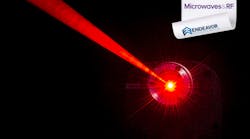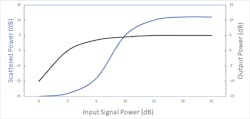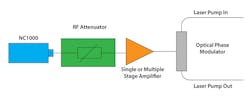This article appeared in Microwaves & RF and has been published here with permission.
What you’ll learn:
- How high-power lasers create damaging return loss (SBS) in fiber-optic cables.
- How AWGN is used to increase optical power in fiber-optic cables.
- Ideal noise-source solutions for DEWs still under test or ready for deployment.
Defense weaponry is a mainstay on the technological frontlines, continually expanding design and performance capabilities to uphold global safety and security from adversaries with hostile intentions. Directed-energy weapons (DEWs) have garnered significant interest from various military branches and research institutions due to a myriad of operational advantages over traditional defense systems.
Laser-based DEWs are powerful ranged weapons that produce a concentrated beam of energy to neutralize targets of interest. Traveling at the speed of light, these highly focused laser beams support a near-infinite range, reduce risk of collateral damage, and provide an endless ammunition supply if drawing from a sufficient power source. Whether launching from air-, land-, or sea-based structures, their platform flexibility expands potential mission locations, no matter the domain.
Although DEWs show promise in tactical campaigns, design and performance issues related to their high-power nature halt the developmental progress at the experimental stage, limiting the possibility of practical, deployment-ready DEWs. This article explores a restricting challenge affecting laser-weapon design, as well as noise-generation solutions that allow DEWs to truly reach their full potential.
Critical DEW Design Challenges
Laser weapons require optical power levels of extreme intensity, but this elevated performance standard comes at a cost. In DEWs, the power output from just one laser module isn’t sufficient, and therefore the output from multiple laser modules must merge to create a single beam of concentrated energy. The total output from the system increases by upping the power per module, which subsequently heightens power levels traveling along the optical fibers.
Although this technique achieves desired standards, it can cause an unwanted phenomenon in the fiber-optic medium—stimulated Brillouin scattering (SBS)—that reduces the efficiency and reliability of the weapon.
As powerful laser beams move through an optical fiber, the beam’s own electric-field variations can produce acoustic vibrations within the fiber-optic core due to a property of dielectric materials known as electrostriction (Fig. 1).
The interaction between the incident optical wave and the medium’s acoustic phonons generates a reflected light beam (Stokes wave) of slightly lower energy traveling in the opposite direction of the initial laser. The reflected wave’s diminished power may cause one to think its impact to operational integrity is trivial, but keep in mind that DEWs operate at extreme power levels. Therefore, even with a reduction in power, the scattered Stokes wave still obtains a very high-power output that ultimately produces a considerable return loss, threatens to damage the source of the laser, and inhibits increasing the power per module (Fig. 2).
Engineers and designers on the cutting edge of defense technology seek SBS reduction techniques so that DEWs can reach optimal performance. A favorable SBS mitigation methodology focuses on minimizing each module’s peak power by spreading the coherence of the laser beam. This begs the question: How can coherence spreading enable extreme power levels in DEW systems if peak power measurements are reduced?
The key to this approach lies in the fact that average power measurements are unfazed. By reducing peak power while maintaining average power readings, the laser system’s overall optical-power output avoids the ill effects of SBS and achieves its all-important intensity.
Laser light emits photons that are in line with each other, meaning they possess a constant relative phase (i.e., are highly coherent). Coherence spreading conditions the signal using phase modulation, where a supplied modulating signal alters the phase of the optical wave.
This process keeps a constant peak amplitude and frequency, but the optical wave’s phase changes in accordance with variations in the modulating signal’s amplitude. As a result, the average power output is preserved while at the same time dispersing peak power levels along the waveform. DEW designs employing coherence-spreading techniques overcome SBS-related challenges that would otherwise impede the development and deployment of advanced laser weaponry.
Coherence Spreading Techniques to Mitigate SBS
To effectively modulate the phase of each laser module in a DEW system, engineers must supply a modulating signal. Typically, two approaches are used in the industry to generate this signal with varying degrees of efficiency. The first methodology involves a bit-error-rate generator, which applies a pseudorandom binary sequence (PRBS) as the modulating signal to drive coherence spreading.
PRBS is a binary sequence produced with a deterministic algorithm that exhibits predictable, cyclical behavior after a certain number of elements. Although a PBRS is a deterministic bit stream, it resembles actual random sequences due to shared statistical qualities.
A bit-error-rate generator injecting a PRBS as a phase-modulation catalyst is an acceptable coherence spreading technique; however, it possesses some considerable drawbacks. This type of instrumentation is both costly and large, taking up valuable real estate throughout production.
In addition, performance variabilities start to surface once these generators are exposed to certain environmental conditions, such as vibrational stress and temperature fluctuations, which impedes ideal function in harsh field conditions. Furthermore, incorporating this instrumentation into a DEW system necessitates adding complex electronics into the laser modules, thus complicating the overall design.
An alternative coherence-spreading approach for high-power DEWs utilizes an additive white Gaussian noise (AWGN) source. As opposed to injecting a repeated, deterministic pulse stream into each laser module, noise-generating components reliably provide a truly random signal in a compact and cost-effective package to manage SBS in advanced defense systems.
Noise sources vary from standalone units with fixed output power levels, to robust generators packed with user-controllable attenuation, filtering, and amplification to determine optimal performance. Mitigating SBS with a noise-source solution may not only lower project cost, but can also provide a more environmentally robust design and simplify operation for test engineers, all of which expedites DEW development.
Noise-Source Solutions for DEW Design and Deployment
Although noise-source solutions are an efficient means of driving coherence spreading, the given stage of production dictates use of different noise-generating devices. Before DEWs are integrated into critical security operations, they must first pass design and performance validation.
In such use cases, designers require the utmost versatility and control over test equipment to finalize the specifications needed for later stages of DEW development. Here, programmable noise generators shine by providing a flexible architecture and high level of noise control. Output from the noise generator is fed through an optical phase modulator, which is directly connected to the laser pump of a weapons system.
Utilizing instrumentation with wide-ranging noise-generation capabilities offers an indispensable freedom of design to pinpoint optimal noise-output requirements that are best suited to reduce SBS in each specific system.
Advanced programmable noise generators serve as complete, self-contained units that deliver unique, sophisticated noise signals, utilizing both precision components with exceptional flatness and high output power. They also provide various adjustable features to generate noise in the proper frequency bands and at the appropriate power levels.
State-of-the-art instrumentation grants superior control over noise output power via attenuation in incremental stages, even as targeted as 0.1-dB steps within a 127-dB dynamic range. The option of customizable filter paths can enable variable video bandwidth (VBW) and frequency-band limitation to identify the laser system’s ideal bandwidth of noise. Furthermore, signal amplification may range up to +30 dBm in leading programmable noise generators, which accelerates spec finalization in proof-of-concept DEWs.
Early periods of weapons evaluation are commonly conducted in controlled and restricted laboratories or benchtop environments. However, real-world conditions aren’t as predictable as test setups with regulated parameters. Thus, engineers utilize advanced testing chambers to examine system resiliency when exposed to environmental stresses typically encountered during field use, including fluctuations in temperature, vibration fatigue, contact with moisture, and altitude variations.
To facilitate this stage of weapons testing, electrical and optical equipment as well as coherence-spreading devices require remote operation. Advanced programmable noise generators offer remote controllability via Ethernet or GPIB connections to promptly uncover any operational faults, paving the way for robust, field-ready DEW designs that are well-suited for military campaigns in demanding terrains.
Programmable noise generators are ideal tools during the beginning stages of design. However, their vast flexibility is no long necessary once laser systems enter production with locked-in specifications. Now, SBS mitigation requires smaller, compact noise sources in even lower-cost form factors, such as a standalone, amplified noise module. These devices can produce the optimal noise power levels and frequency bands determined during lab trials and become the coherence-spreading solution that’s packaged and embedded into the deployed DEW.
Designers typically use a cost-effective noise module as an individual unit, adding their own specific components like attenuators and amplifiers to the production-ready DEW. Leading-edge devices, though, offer various customization options to meet the needs of unique systems.
For example, amplified noise modules in standard configurations may have the capacity to incorporate built-in attenuation and amplification specific to the DEW design. In this case, amplified noise modules with attenuation and amplification capabilities deliver AWGN signals at the required power levels directly to the optical phase modulator (Fig. 3). With these additional features, designers can shift focus and valuable resources onto the production of the system’s optical components. In the end, amplified noise modules minimize physical footprint, reduce project cost, and support the deployment of finalized defense weaponry.
Enabling Robust, Mission-Ready Laser Weapons
Deployed laser-based DEW systems are a technological priority for tactical engagements that neutralize targets deemed a risk to global safety. Although the intense optical power of this weaponry is favorable in various applications, it also causes an SBS phenomenon along the optical fiber of each laser module.
A critical design challenge, SBS impedes high optical power transmission and requires mitigation techniques, such as coherence spreading, which is efficiently achieved with noise-generating sources. Although other methodologies exist, programmable noise generators with flexible architectures and amplified noise modules with fixed output-power levels are ideal solutions that support the entirety of DEW development, from initial concept to deployed, practical, high-powered laser weapons.



